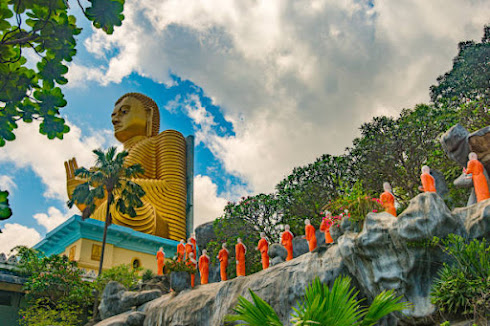Dambulla Cave Temple, also known as the Golden Temple of Dambulla, is a UNESCO World Heritage Site located in the central province of Sri Lanka. The temple is a complex of five caves, each filled with intricate and well-preserved statues and frescoes that tell the story of Buddhism in Sri Lanka. The history of Dambulla Cave Temple dates back to the 1st century BC and it has been expanded and embellished over time. The temple is considered one of the most important Buddhist temples in the country and it is a must-see destination for anyone interested in Sri Lanka's rich cultural heritage. In this blog post, we'll take you on a journey through the Dambulla Cave Temple, highlighting its history, the significance of the statues and frescoes, and tips on how to make the most of your visit. Whether you're a history buff, a photography enthusiast, or just looking for a unique cultural experience, you'll find something to love at the Dambulla Cave Temple.
The history of Dambulla Cave Temple dates back to the 1st
century BC, during the reign of King Valagamba (also known as Vattagamini
Abhaya). The king, who had been exiled from the Anuradhapura Kingdom, took
refuge in the caves and later converted them into a temple. The caves were
further expanded and embellished during the 18th century by King Nissankamalla.
As I stepped into the Dambulla Cave Temple, also known as the Golden Temple of Dambulla, I felt like I was taking a step back in time. The UNESCO World Heritage Site is a complex of five caves, each filled with intricate and well-preserved statues and frescoes that tell the story of Buddhism in Sri Lanka. I was amazed by the golden statues that gleamed in the sunlight filtering through the entrance.
As I made my way through the first cave, known as the Cave
of the Divine King, I was struck by its grandeur. It's the largest and most
impressive of the five caves and contains a 14-meter-long statue of the
reclining Buddha and a series of frescoes depicting scenes from the life of the
Buddha. The intricate details on the statues and frescoes were truly
breathtaking, and I couldn't help but marvel at the skill and craftsmanship of
the ancient artisans.
As I explored the other caves, each one had its own unique collection of statues and frescoes. The second cave, known as the Cave of the Great Kings, contained statues of the four kings who ruled Sri Lanka during the 3rd century BC. The third cave, known as the Cave of the Great New Monastery, is the most recent addition to the temple and contains a number of statues and frescoes depicting the life of the Buddha. The fourth cave, known as the Cave of the Great Treasury, is the smallest of the five caves but contains some of the most impressive frescoes in the temple. The fifth cave, known as the Cave of the Great Pavilion, is the second-largest cave and contains a statue of the standing Buddha as well as a number of frescoes.
As I walked through the caves, I couldn't help but notice the peaceful silence that surrounded the temple. It's the perfect place for meditation and reflection, and I found many visitors sitting in silence, taking in the serene atmosphere. I couldn't resist taking my own photos, as the temple's golden statues and frescoes provided a stunning backdrop.
My visit to the Dambulla Cave Temple was an unforgettable experience, not only for the rich cultural and historical significance but also for the natural beauty of the surrounding area. The temple is located on a hilltop and offers a panoramic view of the surrounding landscape. I was lucky enough to catch a sunset, and I watched as the sky changed colors as the sun went down.
I highly recommend taking a guided tour when visiting the Dambulla Cave Temple, as it will help you fully understand the significance of the statues and frescoes. A guide can also provide information on the history and cultural significance of the temple, as well as tips on how to make the most of your visit. The temple is open daily from 6 am to 6 pm, and it's best to visit early in the morning or late in the afternoon to avoid the crowds.
In conclusion, a visit to the Dambulla Cave Temple is a
must-see destination for anyone interested in Sri Lanka's rich cultural
heritage. The complex of five caves is a beautiful example of ancient rock-cut
architecture and is home to a wealth of statues and frescoes that tell the
story of Buddhism in Sri Lanka. The natural beauty of the surrounding area and
the peaceful atmosphere make it an ideal destination for anyone looking for a
unique cultural experience. The Dambulla Cave Temple is a place where history,
culture, and nature come together to create an unforgettable experience that
will stay with you long after you've left.











0 Comments